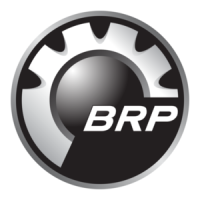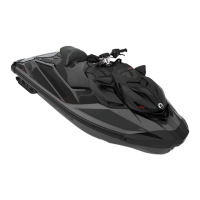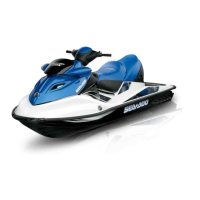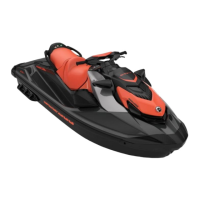
Do you have a question about the BRP Sea-Doo GTX 300 2022 and is the answer not in the manual?
Scan for others, maintain distance, use throttle to steer.
Ensure riders are seated, holding on, and wearing PFDs.
Essential precautions and information before operating the watercraft.
Proper use and importance of the tether cord.
Instructions for safely carrying passengers.
Strategies for preventing collisions on the water.
Hazards and prevention of carbon monoxide exposure.
Safety precautions regarding gasoline and fire.
Step-by-step instructions for refueling the watercraft.
Checklist of items to inspect before launching.
Checks to perform after launching and before riding.
Safety switch to stop the engine immediately.
Powers the electrical system and starts/stops engine.
Electronically controls brake, reverse, and neutral.
Important vehicle condition messages displayed.
Warning and telltale lights for vehicle status.
Setting up ski mode for towing.
Guidelines for the initial 10-hour break-in period.
Safe methods for boarding the watercraft.
Steps for starting the engine safely.
Methods to shut off the engine.
Guidance on steering and handling.
Using the iBR brake system.
Using the iDF system to clear debris.
Provides instant throttle response and rapid acceleration.
Mode for repeated launches and set towing speed.
Procedures for cleaning intake and impeller.
Procedures for righting a capsized watercraft.
Steps to limit engine damage after submersion.
Warnings and procedures for a water-flooded engine.
Annual or 100-hour maintenance tasks.
Instructions for engine oil type and checking level.
Information on coolant type and checking level.
Procedures for removing and installing spark plugs.
Information on flushing the exhaust system.
Tasks for storing the watercraft, including fuel system inspection.
Steps for preparing the watercraft for the season.
Details on engine type, power, induction, cylinders, bore, stroke, compression.
Coolant type and system capacity.
Engine oil type and capacity.
Fuel injection, type, recommended octane, tank capacity.
Ignition system, battery, and spark plug specifications.
Dry weight, passenger limit, storage capacity.
Steps to diagnose and resolve engine start issues.
Troubleshooting steps when the engine cranks but won't start.
Causes and solutions for engine smoke.
Troubleshooting causes for lack of acceleration or power.
Diagnosing and fixing issues preventing top speed.
Potential causes and solutions for slow engine cranking.
Diagnosing and fixing engine misfires or irregular running.
Diagnosing and resolving engine overheating issues.
How fault codes are recorded and displayed.












